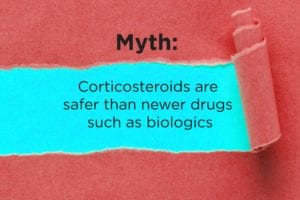Glucocorticoids are the most widely used medication for many types of inflammatory arthritis. They are taken to reduce inflammation, which can relieve arthritis symptoms like joint swelling and pain.
The drugs are synthetic versions of a type of steroid produced naturally by the outer layer (cortex) of the adrenal gland to counteract inflammation and also help in metabolism. The adrenal gland also produces mineralocorticoids that regulate the balance of salt and water. The joint name given for the two hormones is corticosteroids.
When we refer to corticosteroids, we are commonly referring to glucocorticoids, the only type used in arthritis treatment. Examples of these drugs include prednisone and prednisolone. Since the drugs were first tried in a patient with rheumatoid arthritis (RA) in 1948, corticosteroids have been used in a variety of forms and doses for many types of arthritis and other inflammatory diseases. Because of multiple side effects that can occur with corticosteroids, over the years there has been a trend toward using lower doses and for shorter periods of time.
We put your concerns and perceptions about taking corticosteroids to John M. Davis III, MD, MS, a rheumatologist at the center where the drugs were first used to treat RA, the Mayo Clinic in Rochester, Minnesota. Here, we separate myths from facts about corticosteroids for arthritis so you can get the most from your treatment, use it safely, and help prevent side effects.
Myth: Corticosteroids are only good for inflammatory arthritis
While oral corticosteroids are best known as part of treatment for many types of inflammatory arthritis, the Osteoarthritis Research Society International endorses the use of intra-articular (directly into the joint) injections of corticosteroids for knee and hip osteoarthritis. The American College of Rheumatology conditionally recommends (weaker than the strong recommendation they give some other therapies) the intra-articular steroid injections for hip and knee arthritis, while it conditionally recommends against them in osteoarthritis of the hands. Read more about how steroid injections can help treat arthritis.
Recent preliminary research suggests that even oral corticosteroids may have value in treating osteoarthritis. Data from the annual European Congress of Rheumatology (EULAR 2019) found that low-dose prednisolone (a type of glucocorticoid) significantly reduced pain and improved functioning in people with hand OA. In recent years experts have come to believe that inflammatory processes also play a major role in osteoarthritis, which has typically been thought of as a “wear-and-tear” kind of arthritis that occurs from physical stress to a joint. That might explain why a drug such as prednisolone could have a positive impact.
Myth: Steroid shots are painful and dangerous
While no one would say steroid shots are fun, injecting a corticosteroid directly into a joint can provide relief by putting the drug’s anti-inflammatory power right where you need it most. To minimize discomfort, your skin may be sprayed with an aerosol coolant to numb the area, and a local anesthetic (such as lidocaine) is typically delivered along with the steroid to provide immediate pain relief. Apply ice to the injection site as needed if you have pain or swelling in the days after the injection. After that initial uptick in discomfort, you may gain months of relief.
As for safety, there is a small risk that an injection will result in infection or damage to a nerve or tendon. Repeated injections into the same joint carries a small risk of thinning the cartilage in the joint, so the number of injections you can get per year will be limited. There’s no set number, but as a general rule, doctors limit the number of steroid injections you can get in a joint to no more than three to four a year.
“In many situations, the benefits of intra-articular corticosteroid therapy outweigh the potential risks when one or two joints are involved, especially relative to oral therapy,” says Dr. Davis.
Myth: Taking steroids is the same as athletic doping
Repeat after us: Not at all. In fact, corticosteroids are more likely to shrink your muscles than to help you bulk up. All steroids contain a similar four-ring structure at their core, but other parts of each compound make them behave very differently. Corticosteroids, the type used in arthritis treatment, calm the immune system and reduce inflammation. Anabolic steroids, the type used in doping, are synthetic hormones similar in structure to the male sex hormone testosterone.
“Unlike anabolic steroids, which increase muscle mass, corticosteroids may induce muscle atrophy at high doses or with long-term use,” says Dr. Davis.
This, along with the fact that corticosteroid can weaken your bones, means that taking them can increase your risk of osteoporosis and fractures. Here’s more on how to protect your bones while taking corticosteroids.
Myth: Corticosteroids are safer than newer drugs such as biologics
This isn’t necessarily true. Take infection risk, for example. While you hear lots about infection risk in the rapid-fire side effects recitation in ads for biologics, the lack of ads for corticosteroids shouldn’t make you assume the risk is less.
“In many large studies of the risks of infections when taking corticosteroids, conventional disease-modifying drugs, and biologic agents, the highest risk of infection is in the group of patients exposed to prednisone — and the risk goes up with higher dosages,” says Dr. Davis.
The benefits and risks of biologics and corticosteroids vary depending on the specifics of your health, including other medical conditions you have in addition to arthritis. “It is best to discuss the relative benefits and risks of the different types of drugs with your rheumatologist,” Dr. Davis says.
Read more about how corticosteroids affect your infection risk.
Myth: Once you start corticosteroids, you’ll have to take them forever
Actually, doctors try to minimize the duration of steroid use in arthritis patients. “Long-term therapy is something we try to avoid nowadays, for many reasons. There are more effective therapeutic approaches. There are also many adverse effects of corticosteroids that predictably accrue in patients exposed long-term, such as weight gain, diabetes, skin bruising, cataracts, and a higher cardiovascular risk,” Dr. Davis says.
In rheumatoid arthritis, the current strategy recommended by the European Congress of Rheumatology (EULAR) is to use systemic corticosteroids early on, at the lowest dose that reduces pain and swelling, but to keep the treatment short-term (perhaps lasting three and no more than six months before tapering off) and only as an add-on to a disease-modifying anti-rheumatic drug (DMARD) such as methotrexate.
In a study presented at EULAR’s 2019 meeting, people with moderate-to-severe RA who reached remission or low disease activity while taking an interleukin-2 inhibitor biologic (Actemra) along with the corticosteroid prednisone, two-thirds of those who gradually tapered off of prednisone did well. Later in your treatment, corticosteroids may be restarted temporarily if you are switching to a new DMARD or experience a flare.
EULAR also recommends using corticosteroid injections to quiet inflammation in specific joints that fail to respond to the DMARD or flare later on.
Myth: My arthritis will get worse when I stop using steroids
While you’re being treated with a corticosteroid, your adrenal glands will reduce the amount of the hormone cortisol that they naturally produce. After you stop medication, it may take a while for your own production to catch up, which can create temporary withdrawal symptoms such as fatigue and body aches.
There is also the possibility that your arthritis symptoms may worsen as you taper off the medication, called rebound.
“Gradual tapering and good patient education on symptoms and the risk of increased disease activity are really important,” says Dr. Davis.
To minimize the chance of problems, you should carefully follow instructions for gradual tapering off your corticosteroid so your body has time to adjust. Talk to your rheumatologist about your symptoms so you’ll know which may be temporary withdrawal issues and which might indicate heightened disease activity that might warrant a change in your arthritis treatment plan.
Myth: It’s not safe to get pregnant while on corticosteroids
Unlike methotrexate, which must be stopped three months prior to pregnancy to avoid the risk of serious birth defects, corticosteroids may be used — with care and under a doctor’s supervision — if needed during pregnancy.
Concerns were raised by animal studies in the 1950s that corticosteroid exposure during pregnancy might raise the risk of cleft lip or cleft palate, but over the years the actual data in humans was inconsistent. Birth defects researcher Christina D. Chambers, PhD, MPH, recently looked at the data and found that larger, more recent studies don’t show an increased risk.
Other pregnancy problems are a little harder to figure out. Several studies have suggested that the use of oral steroids such as prednisone (especially at higher doses) may increase the risk of a woman developing dangerous high blood pressure, delivering early, or having a low-birthweight baby.
“However, women with more severe or poorly controlled disease can be at increased risk for these same adverse outcomes simply due to their disease activity itself, and these women are more likely to require treatment with steroids and to need higher doses,” says Dr. Chambers, a professor of pediatrics at the University of California, San Diego.
“The bottom line is that when corticosteroids are considered necessary to use in pregnancy, it is desirable to use the lowest dose for the shortest duration that will achieve the desired effect,” Dr. Chambers says. Read more about medication safety in our Patient Guidelines for Family Planning with Arthritis.
Track Your Medications with ArthritisPower
Join CreakyJoints’ patient-centered research registry and log your medications to track side effects and impact on disease activity. Learn more and sign up here.






